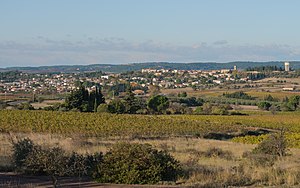Villeveyrac
|
Villeveyrac Vilamanda |
||
|---|---|---|

|
|
|
| region | Occitania | |
| Department | Herault | |
| Arrondissement | Montpellier | |
| Canton | Mèze | |
| Community association | Bassin de Thau | |
| Coordinates | 43 ° 30 ' N , 3 ° 36' E | |
| height | 12-255 m | |
| surface | 37.12 km 2 | |
| Residents | 3,795 (January 1, 2017) | |
| Population density | 102 inhabitants / km 2 | |
| Post Code | 34560 | |
| INSEE code | 34341 | |
| Website | http://villeveyrac.fr/ | |
 Villeveyrac - town view |
||
Villeveyrac ( Occitan : Vilamanda ) is a place and a municipality in the south of France with 3795 inhabitants (as of January 1, 2017) in the Hérault department in the Occitania region .
location
The round village ( Circulade ) Villeveyrac is located on a hill at an altitude of about 75 meters above sea level. d. M. about 29 kilometers (driving distance) southwest of Montpellier or almost 44 kilometers northeast of Béziers . The port city of Sète is about 20 kilometers to the south; the round village of Balaruc-le-Vieux is on the way there. Two other circulades ( Saint-Pons-de-Mauchiens and Saint-Pargoire ) are located about seven kilometers northwest.
Population development
| year | 1968 | 1975 | 1982 | 1990 | 1999 | 2006 | 2017 |
| Residents | 1609 | 1618 | 1686 | 1842 | 2211 | 2758 | 3795 |
In the first half of the 19th century, the population doubled from around 1,000 to around 2,200; thereafter it rose to around 2,750 people. The phylloxera crisis and the progressive mechanization of agriculture led to significant slumps - the population from the 1950s to the 1980s was only around 1,600. Due to the relative proximity to the major cities of Montpellier and Béziers and the significantly lower property prices in the countryside, there has been a significant increase in population again in recent years.
economy
In earlier times, the residents of the village lived largely on self-sufficiency from agriculture, growing not only grain, but also wine and olives. In addition, they ran a little cattle breeding (sheep, pigs, chickens, etc.). As in many places in Languedoc , viticulture dominated in the 19th century; the local wine cooperative marketing the locally produced wine on the appellations Languedoc , Pays d'Herault and Pays d'Oc . Because of the sales crisis for French wine, however, only about half of the agricultural land is still viniculture; on the other half, grain ( wheat , maize ) and sunflowers are grown again. A bauxite mine is operated in the northeast of the municipality .
history
There is no evidence of Roman or Gallo-Roman origins of the place. To the south of today's town was the old town of Veyrac , in which a burial ground, partly from the Visigothic period, was discovered. In a will from the year 990 the place is called Villa Vairago . In 1138 a Benedictine monastery was founded by Raimund I Trencavel , the vice-count of Beziers , which was converted into a Cistercian monastery a few years later (1145) . The beginnings of the Circulade , which belonged to the manor ( seigneurie ) of the Abbey of Valmagne , are likely to have started around this time .
Attractions
- The old town center of Villeveyrac belongs to the type of circulades - round villages that were built around a core consisting of a castle and / or church for defense reasons and whose outer house front served as a replacement for an expensive city wall.
- The parish church ( Église Notre-Dame-de-l'Assomption ) is a building of the 15/16. Century, which got its present appearance in the 19th century.
- The octagonal Protestant church ( temple ) was also built in the 19th century.
- The most important building in the municipality is the former Cistercian Abbey of Valmagne, about three kilometers to the south-west . The well-preserved monastery complex with church, cloister , chapter house and outbuildings has been recognized as a monument historique since 1993 .
- Several stone huts made of dry masonry ( capitelles ), which were used to guard the vineyards before and during the grape harvest , are located in the vicinity of the village.
Web links
- Villeveyrac, wine information (French)
Individual evidence
- ↑ Ancienne abbaye de Sainte-Marie de Valmagne, Villeveyrac in the Base Mérimée of the French Ministry of Culture (French)

